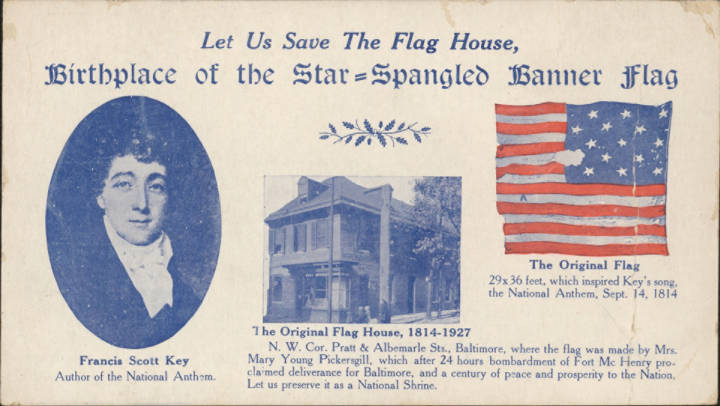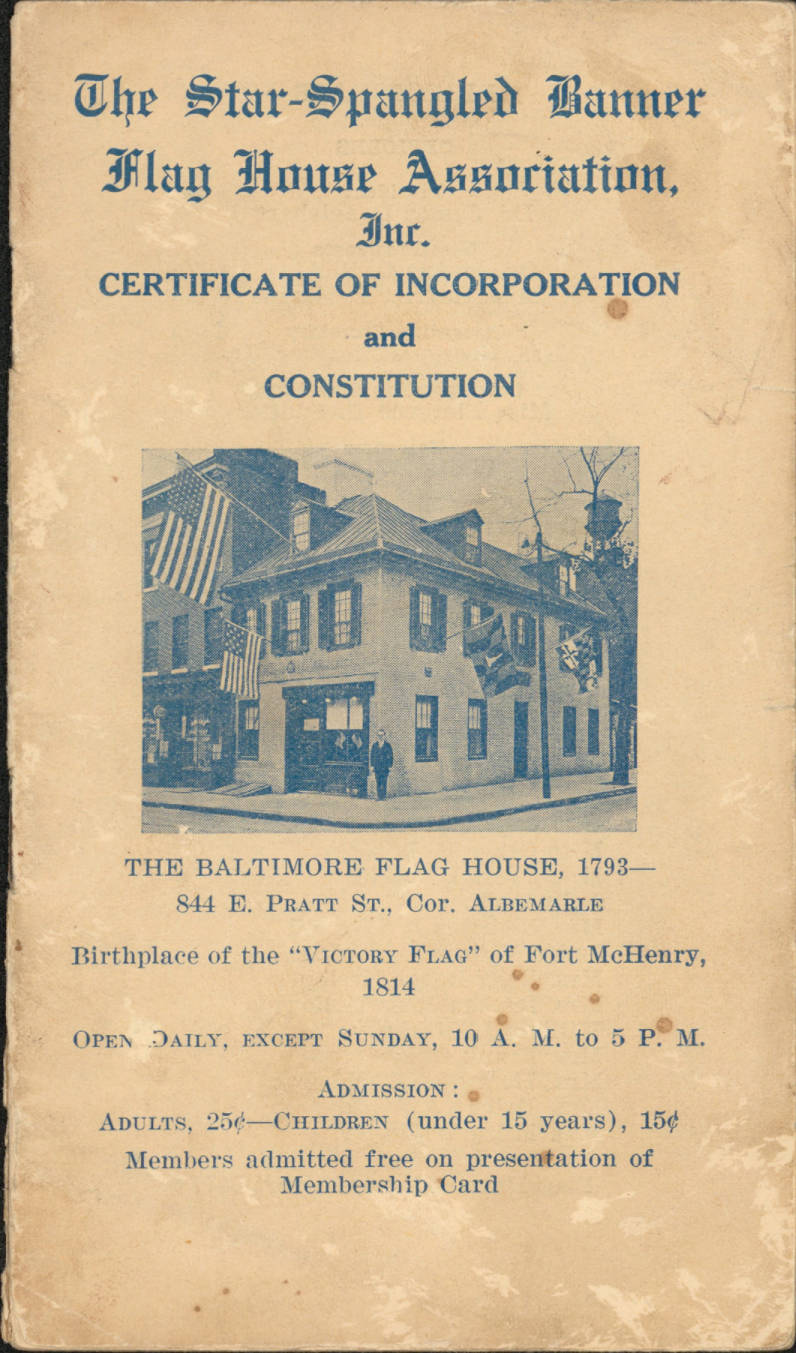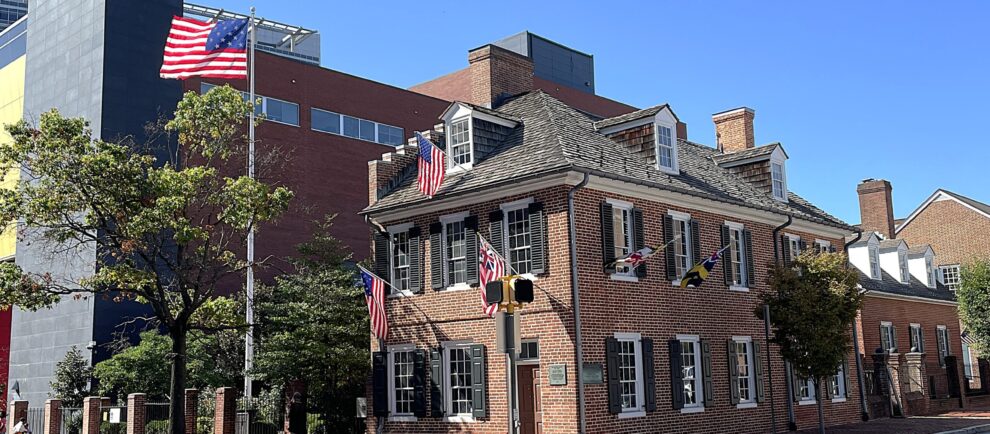March 5, 1906, Mrs. Ruthella Mory Bibbins, a “recent fellow in history at Bryn Mawr College,” gave a lecture for the Women’s College (now Goucher) on “The Federal History of Baltimore and its Memorials.” The lecture included a description of the house where Mary Pickersgill made the Star-Spangled Banner. Later that month, as part of a Goucher College course for teachers on environmental studies, Ruthella Bibbins takes 100 teachers around Baltimore to historic sites, including “Mrs. Pickersgill’s house.” (Baltimore Sun, March 13, 1906) On July 15, 1907, Ruthella called for the house’s preservation after the Star-Spangled Banner flag’s donation to the Smithsonian. Thus begins Ruthella and Dr. Arthur B. Bibbins’ fascination with the Flag House and their attempts to save the house to establish a historic site.
Seven years later, Dr. Bibbins serves as executive chairman of the 1914 National Star-Spangled Banner Centennial, identifying the acquisition of the Flag House as one of its projects, but it does not come to fruition. At this time, the house is the residence and business of Placido Milio, an Italian immigrant and pharmacist who becomes heavily involved in the Sons of Little Italy, acting as an immigration agent and operating a steamship ticket office, and Bank of Naples from the first floor of the Flag House. Once again in 1922, Dr. Bibbins calls for the saving of the Flag House as a place to Americanize people and the Evening Sun reports that it is “the last of the projects planned at the time of the Star-Spangled Banner Centennial in 1914, and the only one not yet carried out.” (Baltimore Evening Sun, October 21, 1922) It was not until 1927 that a campaign was launched to raise money to purchase the Flag House “for patriotic purposes.” Led by Arthur and Ruthella Bibbins and endorsed by patriotic societies. The first meeting of the Flag House Fund Campain Committee was held on February 24, 1927. The Committee circulates postcards reading Let Us Save the Flag House, Birthplace of the Star-Spangled Banner Flag, in March 1927 to raise $10,000. The Committee falls short in their fundraising efforts, and Baltimore City steps in to acquire the deed to 844 E. Pratt Street for $5,000. The Star-Spangled Banner Flag House Association, Inc. was established to operate the historic property with the purpose of “custody, possessions, and management of the said property…to restore the same to the good and same condition as a public shrine.”
On November 11, 1928, the Flag House opened a museum and historic site with a public ceremony held in the front rooms of the first floor.

Mrs. Ruthella Mory Bibbins (1865-1942) and Mr. Arthur B. Bibbins (1860-1936), founders of the Star-Spangled Banner Flag House Association. Mr. Bibbins, a noted geologist, and Mrs. Bibbins a historian who wrote extensively on the history of Maryland and Baltimore were members of the 1914 Star-Spangled Banner Centennial Committee and started lecturing on Baltimore’s historic landmarks as a fellow at Goucher College as early as 1906. A native of Frederick County, Ruthella later lived in Baltimore City, graduating from Goucher College in 1897, then from Oxford a year later, receiving her Ph.D. in history from the University of Chicago in 1900. In 1903, she married Dr. Arthur B. Bibbins, and together they devoted time to patriotic and civic causes in Baltimore, including tours of the historic Flag House starting around 1907 and the eventual founding of the Star-Spangled Banner Flag House Association in 1927. On April 19, 1927, the City of Baltimore acquires deed to 844 E. Pratt for $5,000 from the board of Trustees of the Samuel Ready Asylum for Female Orphans. Star-Spangled Banner Flag House Association Inc. was chartered on the same day. Its purpose is the “custody, possession and management of the said property…to restore the same to good and same condition as a public shrine.” Ruthella and Arthur Bibbins served as founding directors of the Star-Spangled Banner Flag House and purchased or secured the donation of many of the artifacts that remain in the Flag House’s possession today. The Flag House Association, founded by Ruthella and Arthur, gained non-profit status in 1931 and remains the steward organization that operates the museum and historic property for Baltimore City. Like many of the founding directors of the Flag House Association, the Bibbins’ views on nationalism and patriotic education conflict with modern ideals of inclusion and equity. These views are reflected in their published work and the founding documents of the Flag House Association, which state, “Any white person under Twenty-one years of age, having all the other qualifications of the other members, shall be eligible for membership in this Association…”. (Star-Spangled Banner Flag House Association, Inc. Articles of Incorporation, 1927). 93 years later the Flag House is working to reckon with its history of exclusion through the visitor experience, interpretation, and research of its own difficult history.

Meeting Minutes from the first meeting of the Flag House Fund Campaign Committee
February 24, 1927
201 Park Avenue, Baltimore, Maryland
The meeting minutes read – “The first meeting of the Flag House Fund Campaign Committee was called to order by Mrs. A. B. Bibbins at headquarters, 201 Park Ave. on Thursday, Feb. 24th at 2:45 P. Mrs. Bibbins gave an interesting outline of the purchase of the Flag House and her remarks were supplemented by Dr. Bibbins who had served on the Star-Spangled Banner Centennial Committee. Mr. Richard Duvall was nominated temporary chairman and Mr. Walter W. Burns, temporary secretary. The following officers were nominated and elected:
President – Dr. James D. Iglehart
Vice Presidents – Miss Florence P. Sadtler
Henry F. Baker
Dr. Edward L Waters
Recording Secretary – Miss Elizabeth Guy Davis
Corresponding Secretary – Mrs. A. B. Bibbins
Treasurer – Mr. Richard M. Duvall
Legal Advisor – Mr. John L. Sanford
It was moved and recorded that one member of each historical and patriotic society become a member of the Flag House Fun Board and the following were elected:
Mrs. Reuben Ross Holloway, Miss Grace Bouldin, Mr. Frank Quinn, Mrs. Daniel M. Garrison, Miss Harriet Marine, Mrs. Ella Byrd, Mrs. Henry Stockbridge, Mrs. John L. Alcock, Mrs. M. L. Dashiell, Mrs. William F. Pentz, Mrs. Ferdinand Focke, Miss Mary E. Waring, Miss Josephine Lants, Hon. James H. Preston, Mr. Walter W. Burns, Mr. William Tyler Page, Mr. W. Hall Harris, Mr. George L. Radcliffe, Mr. John L. Sanford, Dr. A.B. Bibbins, and Judge Walter I. Dawkins.
It was decided to ask the Board of Estimates for an appropriation at this next meeting, March 1st. There being no further business, the Committee adjourned.
E. G. D.

Let Us Save the Flag House Post Card, March 12, 1927
In order to purchase, restore, and maintain the Flag House, the Bibbinses with the support of the Save the Flag House Committee launched a fundraising campaign with the goal of raising $10,000 – $5,000 for the purchase of the house and $5,000 for maintenance. The Committee would fall short of their goal by the March 12, 1927 deadline, requiring the financial assistance of Baltimore City. The Star-Spangled Banner Flag House Association was incorporated on April 12, 1927.

Informational Booklet, 1927, The Star-Spangled Banner Flag House Association, Inc. Certificate of Incorporation and Constitution

November 11, 1928, the Flag House opens to the public as a historic house museum and shrine. Exhibits include 19th-century furnishings, Young-Pickersgill family objects, and War of 1812 artifacts, anniversary ephemera, and flags.
Back Row L to R: Dr. Arthur B. Bibbins, one of the founders and first Vice President; Mrs. Arthur B. Bibbins, one of the founders and Historian; Mrs. George E. Parker, Jr., Recording Secretary, and Mr. Walter W. Beers, Treasurer.
Second Row: Mrs. John G. H. Lilburn and Miss Grace E. Bouldin.
In the last row wearing the plaid coat is Mrs. Rosa Pirotti Milio, wife of Placido Milio with their son Louis R. Milio. Placido Milio immigrated to the United States around 1907 through Boston. Placido, a pharmacist, moved to Baltimore to work in the Flag House as a pharmacist within Dr. Giampetro’s medical dispensary. From 1908 to 1927, the Milios operated the pharmacy, Italian bank, and agency of the Adams Express Company. Mr. and Mrs. Milio were active in assisting Italian citizens with immigration to the United States, specifically to Baltimore’s Little Italy.

Arthur P. Sewell, first curator of the Star-Spangled Banner Flag House stands at the southeast corner of the historic house in 1928. A veteran of World War I, Mr. Sewell suffered sight loss due to a chemical attack during the war. He and his wife, Elizabeth Murray Sewell, worked together to tackle the restoration, operation, and business affairs of the Flag House, often lecturing around the state and country for various hereditary societies and military groups. As newlyweds in 1928, the Sewells lived on the third floor of the historic Flag House. The couple resided in a third-floor apartment in the Flag House’s attic as late as 1940. Together Arthur and Elizabeth were responsible for the initial preservation of the Flag House restoring it to its approximate 1813 appearance and the expansion of the museum’s footprint to include the first museum and office building (1950). After Arthur’s sudden death in October of 1946, Elizabeth continued on as curator until April 1957. During her tenure as curator, Elizabeth secured the donations of significant artifacts, including many furnishings for the Flag House’s early period rooms and objects related to the life of Francis Scott Key. In September 1958, she donated bound copies of curator’s reports dating back to 1927 for the Flag House archive.
